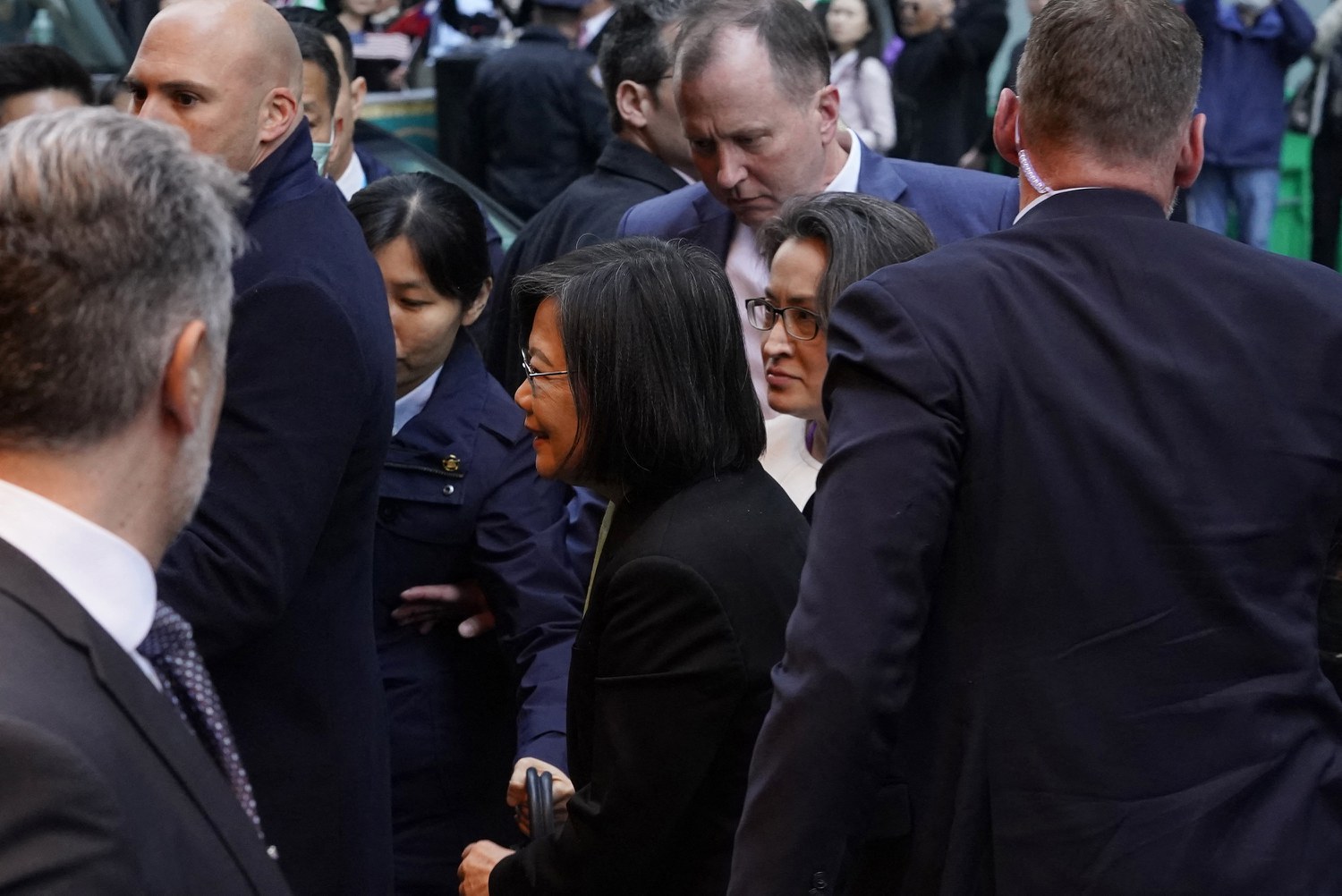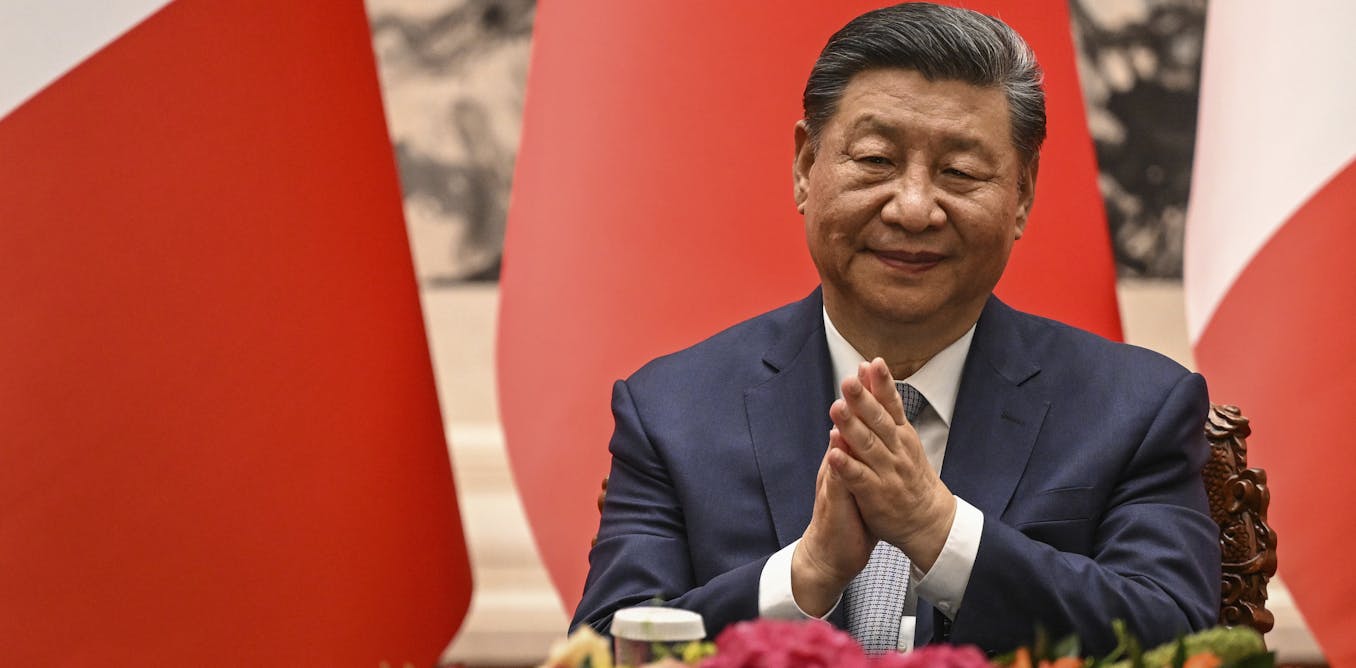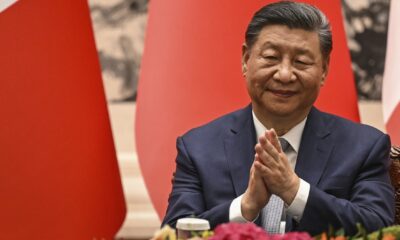China
Tsai arrives in US amid Beijing’s protests

Taiwanese President Tsai Ing-wen arrived in New York on Wednesday amid a war of words between Washington and Beijing about her visit and threats of unspecified “countermeasures” from a Chinese official.
Tsai touched down just before 3 p.m. at John F. Kennedy International Airport and was ushered by security into the Lotte New York Palace hotel on Madison Avenue – past throngs of tussling protesters and supporters being watched closely by police – shortly after 4 p.m.
Armed with banners and loudspeakers, protesters led by the New York Alliance for China’s Peaceful Reunification, a local pro-Beijing group, had arrived early in the day and set up positions along the street.
By the time of Tsai’s arrival, the group easily outnumbered Tsai’s supporters, most of whom did not arrive until about half an hour before the Taiwanese president, and though arguments broke out amid a tense mood, police kept the two groups separate.
A member of the local Chinese community who requested anonymity due to safety concerns told Radio Free Asia he had received a telephone call from the Chinese Consulate in New York asking him to attend the protest to “safeguard the unity of the motherland.”
Travel itinerary
Tsai spends two nights in New York, delivering a speech and receiving a leadership award at the Hudson Institute on Thursday, before departing Friday for official visits to Guatemala and Belize.
She returns on Tuesday to Los Angeles for two more nights in the United States, where she will deliver a speech to the Ronald Reagan Presidential Library and meet House Speaker Kevin McCarthy.
The trip comes amid tensions between China and the United States over Taiwan in the past year, with U.S. officials accusing Beijing of preparing to invade the self-governing island in the coming years and former House Speaker Nancy Pelosi last year visiting the island.
It’s not the first time a Taiwanese leader has “transited” the United States, with the practice starting in the 1990s, but Beijing appears irked by Tsai’s plans to deliver two speeches and meet McCarthy, who has himself suggested he could repeat Pelosi’s visit to Taiwan.
Countermeasures
The response from Beijing – which views Tsai’s trip as part of a growing effort by Taiwan to assert independence – has already been vexed, with a particular fury reserved for the McCarthy meeting.
During a press conference on Wednesday, Zhu Fenglian, spokesperson for the Taiwan Affairs Office of China’s State Council, threatened “countermeasures” if Tsai meets with McCarthy.
“If she has contact with U.S. House Speaker McCarthy, it will be another provocation that seriously violates the ‘One China’ principle, harms China’s sovereignty and territorial integrity, and destroys peace and stability in the Taiwan Strait,” Zhu said before Tsai’s departure.
“We firmly oppose this and will take resolute countermeasures.”

But U.S. officials say the “transit” – Tsai’s seventh time in the United States as Taiwan’s leader – does not constitute an official visit. Instead, they insist that Taiwan’s leader is visiting in a private capacity, and say it’s a standard practice for leaders of the democratic island.
Beijing, though, regards Taiwan a renegade province and has threatened to forcibly “reunite” it with the mainland, and says American relations with Taiwan violate a 50-year-old agreement.
Chinese officials also deny that such “transits” are standard.
Foreign Ministry spokesperson Mao Ning said Wednesday that the United States was “hollowing out the ‘One China’ principle” and that “past mistakes do not justify any new mistake.”
“The ones who are creating the problem and making provocations is not China, but the U.S. and the ‘Taiwan independence’ separatists,” Mao said. “We urge the U.S. to abide by the ‘One China’ principle.”
Mao called on the United States to “earnestly deliver on its leaders’ commitment of not supporting ‘Taiwan independence’ or ‘two Chinas’ or ‘One China, one Taiwan,’ stop all forms of official interaction with Taiwan,” and to stop “upgrading” its relationship with Taiwan.
‘External pressure’
Leaving Taiwan on Wednesday, Tsai pledged not to be swayed.
“I want to tell the whole world democratic Taiwan will resolutely safeguard the values of freedom and democracy, and will continue to be a force for good in the world, continuing a cycle of goodness, strengthening the resilience of democracy in the world,” Tsai said.
“External pressure,” she added, in reference to the backlash from Beijing, would not “obstruct” Taiwan’s engagement with the world.

U.S. officials say Tsai will not meet with anyone from the Biden administration during her six days in total on American soil.
State Department principal deputy spokesperson Vedant Patel reiterated Wednesday that Tsai’s trip was “consistent with our unofficial nature of relations with Taiwan” and did not alter “our ‘One China’ policy,” which diverges from Beijing’s “One China” principle.
“There is no reason to take countermeasures; there’s no reason for Beijing to turn this transit, which is consistent with long-standing U.S. policy, into something it’s not, or to overreact,” Patel told reporters.
“We oppose any unilateral changes to the status quo, from either side. We don’t support Taiwan independence and we continue to expect that cross-strait differences be resolved through peaceful means.”
But Patel declined to comment on McCarthy’s plans, saying they were his prerogative as a leader of a “co-equal branch of government.”
Edited by Malcolm Foster
Read the rest of this article here >>> Tsai arrives in US amid Beijing’s protests
China
Italy and China New DTA Set to Take Effect in 2025: Important Changes and Implications

Italy ratified an upgraded Double Tax Agreement (DTA) with China, effective in 2025, to reduce tax burdens, prevent evasion, and enhance investment. The DTA introduces modern provisions aligned with international standards, targeting tax avoidance and improving dispute resolution for Italian businesses.
Italy recently ratified the upgraded Double Tax Agreement (DTA), which will finally take effect in 2025. This agreement was signed in 2019 and was designed to reduce tax burdens, prevent tax evasion, and promote Italian investment in China.
On November 5, 2024, Italy’s Chamber of Deputies gave final approval to the ratification of the 2019 Double Tax Agreement (DTA) between Italy and China (hereinafter, referred to as the “new DTA”).
Set to take effect in 2025, the new DTA is aimed at eliminating double taxation on income, preventing tax evasion, and creating a more favorable environment for Italian businesses operating in China.
The ratification bill for the new DTA consists of four articles, with Article 3 detailing the financial provisions. Starting in 2025, the implementation costs of the agreement are estimated at €10.86 million (US$11.49 million) annually. These costs will be covered by a reduction in the special current expenditure fund allocated in the Italian Ministry of Economy’s 2024 budget, partially drawing from the reserve for the Italian Ministry of Foreign Affairs.
During the parliamentary debate, Deputy Foreign Minister Edmondo Cirielli emphasized the new DTA’s strategic importance, noting that the agreement redefines Italy’s economic and financial framework with China. Cirielli highlighted that the DTA not only strengthens relations with the Chinese government but also supports Italian businesses, which face increasing competition as other European countries have already established double taxation agreements with China. This ratification, therefore, is part of a broader series of diplomatic and economic engagements, leading up to a forthcoming visit by the President of the Italian Republic to China, underscoring Italy’s commitment to fostering bilateral relations and supporting its businesses in China’s complex market landscape.
The newly signed DTA between Italy and China, introduces several modernized provisions aligned with international tax frameworks. Replacing the 1986 DTA, the agreement adopts measures from the OECD/G20 Base Erosion and Profit Shifting (BEPS) Project and the OECD Multilateral Instrument (MLI), targeting tax avoidance and improving dispute resolution.
The Principal Purpose Test (PPT) clause, inspired by BEPS, is one of the central updates in the new DTA, working to prevent treaty abuse. This clause allows tax benefits to be denied if one of the primary purposes of a transaction or arrangement was to gain a tax advantage, a move to counter tax evasion through treaty-shopping.
| This article was first published by China Briefing , which is produced by Dezan Shira & Associates. The firm assists foreign investors throughout Asia from offices across the world, including in in China, Hong Kong, Vietnam, Singapore, and India . Readers may write to info@dezshira.com for more support. |
Read the rest of the original article.
Business
China’s New Home Prices Stabilize After 17-Month Decline Following Support Measures

China’s new home prices fell for the 17th month in October, declining 0.5% from September, but slowing, indicating potential market stabilization amid supportive measures. Second-hand home prices showed mixed trends.
Decline in China’s Home Prices Stabilizes
China’s new home prices continued to decline in October for the 17th consecutive month, although the drop showed signs of slowing. Recent support measures from Beijing appear to be inching the market toward stabilization, as evidenced by a lighter decline compared to earlier months.
Monthly and Yearly Comparisons
According to the latest data from the National Bureau of Statistics, new home prices across 70 mainland cities fell by 0.5% from September, marking the smallest decrease in seven months. Year-on-year, prices dropped by 6.2%, slightly worse than the September decline of 6.1%. In tier-1 cities like Beijing and Shanghai, prices decreased by 0.2%, a smaller fall than 0.5% in the previous month.
Second-Hand Home Market Trends
Second-hand home prices in tier-1 cities experienced a 0.4% increase in October, reversing a 13-month downward trend. Conversely, tier-2 cities observed a 0.4% drop in second-hand prices, while tier-3 cities faced a similar 0.5% decline. Overall, recent trends indicate a potential stabilization in China’s property market.
Source : China’s new home prices slow 17-month decline after support measures kick in
China
U.S. national debt is its Achilles’ heel, but China sees it as an opportunity

China is emerging as a dominant force in the Global South, challenging U.S. dollar hegemony by increasing gold reserves and reducing U.S. debt holdings, aiming for a multipolar economic landscape.
China is gradually establishing itself as a major player in what has recently been called the Global South, previously known as the Non-Aligned Movement. Over the last few decades, China has become the world’s biggest creditor of developing countries. That has prompted many to fear that it will subjugate partners through the “debt trap” and use this to establish a “hegemonic sphere of influence.”
China’s economic position is so strong that it is now considered the main threat to the U.S. dollar. It is an influential member of the BRICS+ group (which also includes Brazil, Russia, India and South Africa). This group is working to establish a multipolar world that challenges the hegemony of the West, specifically the leadership of the United States. I analyzed this issue in a previous article.
Without using the term “threat,” the U.S. administration now sees China as the “most serious long-term challenge” to the international order. It’s easy to understand why, since China’s strategic objective is to put an end to the supremacy of the U.S. dollar, the keystone of U.S. hegemony.
As a researcher in international political economy at the Université Laval, I am looking at the role China is playing in the dedollarization of the world.
The stronghold of the U.S. dollar
The supremacy of the U.S. dollar underpins American hegemony in the current international order, as French economist Denis Durand explains in his article Guerre monétaire internationale: l’hégémonie du dollar contestée? (International currency war: the dollar’s hegemony challenged?).
In addition to the fact that several currencies are linked to the dollar by a fixed link or band of fluctuation, American currency is also used in many Third World and Eastern European countries, where it enjoys a much higher level of public confidence than do local currencies. […] The United States is the only power that can incur foreign debt in its own currency.
The hegemony of the U.S. dollar over the world economy is reflected in its over-representation in the foreign exchange reserves held by the world’s central banks. The greenback still outstrips other currencies even though there has been some erosion in this.
Despite a fall of 12 percentage points between 1999 and 2021, the share of the U.S. dollar in the official assets of the world’s central banks remains fairly stable at around 58-59 per cent.
U.S. currency still enjoys widespread confidence around the world, reinforcing its status as the preeminent reserve currency. The U.S. dollar reserves of the world’s central banks are invested in U.S. Treasury bills on the U.S. capital market, helping to reduce the cost of financing both government debt and private investment in the United States.
However, the income generated for the U.S. economy by the hegemony of its dollar could also collapse like a house of cards. Durand makes this point when he writes that “the monetary hegemony of the United States […] is held together only by the confidence of economic agents around the world in the American dollar.”
There are two reasons that the world’s confidence in the U.S. dollar could decrease.
Firstly, as U.S. Treasury Secretary Janet Yellen admitted in an interview in April 2023, the United States is unequivocally using its dollar as a tool to bend enemies — but also some recalcitrant allies — to its will. This could ultimately undermine the dollar’s hegemony.
On the other hand, the U.S. debt situation, particularly its unsustainability, is a source of concern that could affect the dollar’s attractiveness as a global reserve currency.
Unsustainable debt
The U.S. dollar has been at the heart of the international monetary system since 1944, and even more so since the Bretton Woods Agreement came into force in 1959.
The Bretton Woods system was based on both gold and the greenback, which was the only currency convertible into gold; this convertibility was fixed at the rate of $35 per ounce.
That changed on Aug. 15, 1971, when, because of inflation and the growing imbalances in the United States’ international economic relations, Richard Nixon announced the end of the dollar’s convertibility into gold.
With the dollar pegged to gold, the United States’ ability to take on debt to meet public spending was limited. Under the gold-based system, where gold was the guarantor of the U.S. currency, the United States could only borrow according to the quantity of dollars in circulation and its gold reserves.
Abandoning the gold-based system gave the U.S. free rein over its debt. In 2023, the U.S. public debt reached more than $33.4 trillion, nine times the country’s debt in 1990.
This astronomical figure continues to raise concerns about its long-term sustainability. As U.S. Federal Reserve Chairman Jerome Powell has pointed out, U.S. debt is growing faster than the economy, making it unsustainable in the long term.
An opportunity for China
This is a reality to which China is clearly attuned, since it recently undertook a massive sell-off of the U.S. debt it owned. Between 2016 and 2023, China sold $600 billion worth of U.S. bonds.
However, in August 2017 China was the United States’ largest creditor, ahead of Japan. It held more than $1.146 billion in U.S. Treasuries, almost 20 per cent of the amount held by all foreign governments. Beijing is now the second-largest foreign holder of U.S. debt, with a claim of around $816 billion.
It is certainly no coincidence that before divesting itself of U.S. bonds, Beijing first launched its own gold pricing system in yuan. In fact, on April 19, 2016, the Shanghai Gold Exchange, China’s operator for precious metals, unveiled on its website its first “fixed” daily benchmark for gold at 256.92 yuan per gram.
This policy is part of China’s strategy to make gold a tangible guarantee of its currency.
China’s “Gold for Dollars” strategy
China is also selling its U.S. bonds. According to the U.S. Treasury, between March 2023 and March 2024, China sold off $100 billion in U.S. Treasuries, on top of the $300 billion it had already sold off over the past decade.
At the same time, the Middle Kingdom has replaced around a quarter of the U.S. Treasuries sold in 10 years with gold, of which it is now the leading producer and consumer. Like China’s central bank, other central banks in emerging countries continue to buy gold.
China’s appetite for gold was confirmed in 2010, when its gold reserves rose to 1,054 tonnes, from around 600 tonnes in 2005. Ten years later, in 2020, its stock of gold had almost doubled again, to nearly 2,000 tonnes. By the end of 2023, with a gold reserve of 2,235 tonnes, China will be the country with the sixth-largest gold reserve.
As a substitute for the dollar, gold enables China to store the gains from its large trade surpluses. With the Shanghai Gold Exchange, which offers gold trading contracts in Yuan, Beijing is seeking to strengthen the use of its currency abroad with the aim of establishing the yuan as the benchmark currency for the global economy.
This article is republished from The Conversation under a Creative Commons license. Read the original article.






